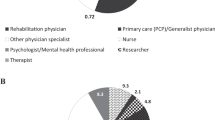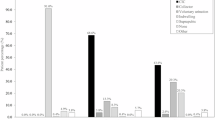Abstract
Study design:
Qualitative study using individual in-depth interviews.
Objectives:
The objective of this study was to explore the factors influencing the choice of bladder management for male patients with spinal cord injury (SCI).
Setting:
Public hospitals in Malaysia.
Methods:
Semistructured (one-on-one) interviews of 17 patients with SCI; 7 were in-patients with a recent injury and 10 lived in the community. All had a neurogenic bladder and were on various methods of bladder drainage. Interviews were audio-recorded, transcribed verbatim and analyzed using thematic analyses.
Results:
The choice of bladder management was influenced by treatment attributes, patients’ physical and psychological attributes, health practitioners’ influences and social attributes. Participants were more likely to choose a treatment option that was perceived to be convenient to execute and helped maintain continence. The influence of potential treatment complications on decision making was more variable. Health professionals’ and peers’ opinions on treatment options had a significant influence on participants’ decision. In addition, patients’ choices depended on their physical ability to carry out the task, the level of family support received and the anticipated level of social activities. Psychological factors such as embarrassment with using urine bags, confidence in self-catheterization and satisfaction with the current method also influenced the choice of bladder management method.
Conclusion:
The choice of bladder management in people with SCI is influenced by a variety of factors and must be individualized. Health professionals should consider these factors when supporting patients in making decisions about their treatment options.
Similar content being viewed by others
Log in or create a free account to read this content
Gain free access to this article, as well as selected content from this journal and more on nature.com
or
References
Wolfe DL, Ethans K, Hill D, Hsieh JTC, Mehta S, Teasell RW et al. Bladder health and function following spinal cord injury. In: Eng JJ, Teasell RW, Miller WC, Wolfe DL, Townson AF, Hsieh JHC, et al (eds). Spinal Cord Injury Rehabilitation Evidence. Vancouver. 2010 pp 1–19.
Wyndaele JJ, Madersbacher H, Kovindha A . Conservative treatment of the neuropathic bladder in spinal cord injured patients. Spinal Cord 2001; 39: 294–300.
Cameron AP, Wallner LP, Tate DG, Sarma AV, Rodriguez GM, Clemens JQ . Bladder management after spinal cord injury in the United States 1972 to 2005. J Urol 2010; 184: 213–217.
El-Masri WS, Chong T, Kyriakider AE, Wang D . Long-term follow-up study of outcomes of bladder management in spinal cord injury patients under the care of the Midlands Centre for Spinal Injuries in Oswestry. Spinal Cord 2012; 50: 14–21.
Yavuzer G, Gok H, Tuncer S, Soygur T, Arikan N, Arasil T . Compliance with bladder management in spinal cord injury patients. Spinal Cord 2000; 38: 762–765.
Abrams P, Agarwal M, Drake M, El-Masri W, Fulford S, Reids S et al. A proposed guideline for the urological management of patients with spinal cord injury. BJU Int 2008; 101: 989–994.
Jamison J, Maguire S, McCann J . Catheter policies for management of long term voiding problems in adults with neurogenic bladder disorders. Cochrane Database Syst Rev 2011; 12: CD004375.
Stacey D, Bennett C, Barry MJ, Col NF, Eden KB, Holmes-Rovner M et al. Decision aids for people facing health treatment or screening decisions. Cochrane Database Syst Rev 2011; 10: CD001431.
Sandelowski M . Focus on research methods. Whatever happened to qualitative description? Res Nurs Health 2000; 23: 334–340.
Creswell JW, Plano Clark VL (eds). Collecting data in mixed methods research. In:. Designing and Conducting Mixed Method Research. Sage Publications: Thousand Oaks, CA. 2011 pp 173–174.
Janis IL, Mann L . A conflict model of decision making. In:. Decision Making: A Psychological Analysis of Conflict, Choice and Commitment. Free Press: New York, NY, USA. 1977 pp 45–80.
Morse J . Designing funded qualitative research. In: Denzin N, Lincoln Y (eds). Handbook for Qualitative Research. Sage Publication: Thousand Oaks, CA. 1994 pp 220–235.
Braun V, Clarke V . Using thematic analysis in psychology. Qual Res Psychol 2006; 3: 77–101.
Sand Å, Karlberg I, Kreuter M . Spinal cord injured persons’ conceptions of hospital care, rehabilitation, and a new life situation. Scand J Occup Ther 2006; 13: 183–192.
Pellatt GC . Patient–professional partnership in spinal injury rehabilitation. Br J Nurs 2004; 13: 948–953.
Burkell JA, Wolfe DL, Potter PJ, Jutai JW . Information needs and information sources of individuals living with spinal cord injury. Health Info Libr J 2006; 23: 257–265.
Veith EM, Sherman JE, Pellino TA, Yasui NY . Qualitative analysis of the peer mentoring relationship among individuals with spinal cord injury. Rehabil Psychol 2006; 51: 289–298.
Haas BM, Price L, Freeman JA . Qualitative evaluation of a community peer support service for people with spinal cord injury. Spinal Cord 2013; 51: 295–299.
Sweeney A, Harrington A, Button D . Suprapubic catheters: a shared understanding, from the other side looking. J Wound Ostomy Continenence Nurs 2007; 34: 418–424.
Bergmark BA, Winograd CH, Koopman C . Residence and quality of life determinants for adults with tetraplegia of traumatic spinal cord injury etiology. Spinal Cord 2008; 46: 684–689.
Carpenter C . The experience of spinal cord injury: The individual’s perspective-Implications for rehabilitation practice. Phys Ther 1994; 74: 614–628.
Acknowledgements
We thank the Director of Health Malaysia for permission to publish this paper. The study was funded by the BKP Grant from University of Malaya, Malaysia (BKP002-2012A).
Author information
Authors and Affiliations
Corresponding author
Ethics declarations
Competing interests
The authors declare no conflict of interest.
Rights and permissions
About this article
Cite this article
Engkasan, J., Ng, C. & Low, W. Factors influencing bladder management in male patients with spinal cord injury: a qualitative study. Spinal Cord 52, 157–162 (2014). https://doi.org/10.1038/sc.2013.145
Received:
Revised:
Accepted:
Published:
Issue date:
DOI: https://doi.org/10.1038/sc.2013.145
Keywords
This article is cited by
-
Experiences of people with spinal cord injuries readmitted for continence-related complications: a qualitative descriptive study
Spinal Cord (2024)
-
Pulse article: survey of neurogenic bladder management in spinal cord injury patients around the world
Spinal Cord Series and Cases (2021)
-
Stigma and self-management: an Interpretative Phenomenological Analysis of the impact of chronic recurrent urinary tract infections after spinal cord injury
Spinal Cord Series and Cases (2018)
-
Current and future international patterns of care of neurogenic bladder after spinal cord injury
World Journal of Urology (2018)
-
Associations with being physically active and the achievement of WHO recommendations on physical activity in people with spinal cord injury
Spinal Cord (2017)



